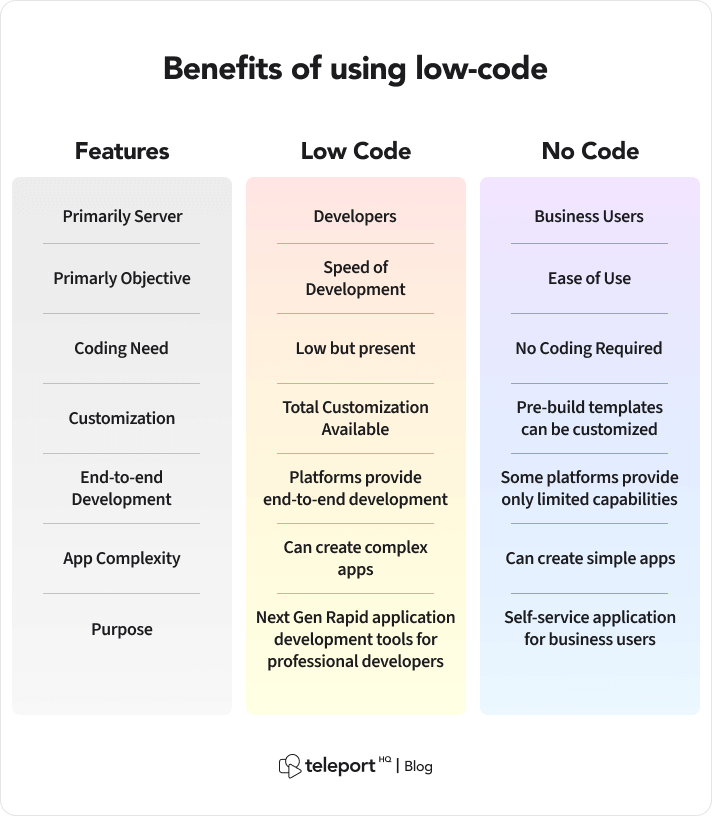Recommended Suggestions For Choosing Low-code platforms for application development
Wiki Article
The Accessibility Of Low-Code Applications Is One Of The Biggest Benefits.
Due to several factors, low-code application development is more accessible for non-developers. These are sometimes referred to as "citizens developers."
Drag-anddrop Builders: Lowcode platforms provide drag-and-drop interfaces, which allow nondevelopers to visually create applications, without needing code. This makes the process of developing easier for people with technical backgrounds.
WYSIWYG editors The WYSIWYG editors "What You See Is What You Get" editors allow users to build interfaces and workflows that look identical to the finished version. This makes it simpler to learn and use.
Simple Workflow and Logic Design:
Visual Workflow Design: Users are able to easily create business processes and application logic using flowcharts, models and diagrams. They are much easier to work with than traditional coding.
Low-code platforms typically come with pre-built logic elements (e.g. the conditional statements, loops) which eliminate the need for complicated programming.
Reusable Components and Templates
Library of pre-built templates A lot of low-code platforms provide a library of templates for the most common types of applications which allow non-developers to start with a solid foundation to modify as they need to.
Reusable widgets and modules: The development of websites is made easier by using reusable components and modules. This means that there is less requirement for technical expertise.
Tutorials and guide development:
Step-by-Step Guides: Platforms frequently provide guided development pathways, online tutorials, or screen-based instructions that can assist users who aren't developers to create applications.
Interactive Tutorials Interactive tutorials are hands-on and interactive that allow users to learn through doing. This boosts the confidence of users in the platform.
Integration with tools already in use:
seamless integration: Low-code platform are designed to seamlessly integrate with the existing systems, tools, as well as software (e.g., ERP and CRM). This enables non-developers who don't have a background in programming to build applications that can work with their current workflows.
APIs, connectors: These tools simplify integration by allowing non-developers (or even users) to connect their apps with external services.
Collaboration Features:
Team Collaboration - Features such as real-time team collaboration, and shared workspaces help non-developers collaborate effectively with analysts, professionals, developers, and stakeholders.
Access levels are able to be set for those who are not developers in order to ensure that they are able contribute to development, without compromising security.
Automated Debugging, Testing and Debugging
Low-code platforms are usually equipped with debugging and testing software that automates these procedures. This makes it simpler for non developers to verify the functionality of their apps.
Error Highlighting When problems occur, the platform highlights these and suggests solutions. It helps non-developers in solving the issue.
The ability of low-code applications to facilitate development for those who are not developers is its main advantage. Platforms with low-code enable business users by providing them with intuitive, visual and guided tools. They are then able to actively participate in developing and maintaining the applications. View the top rated Low-code Platform for application development hints for more examples including develop web app, app development platform, azure sql server, low code development platforms, app modernization, cross platform mobile development, push notifications, push notifications, cross platform mobile dev, application modernisation and more.

Benefits Of Low-Code Application Development In Security And Governance
Low-code development of apps offers numerous advantages in terms of governance and security. This is vital to ensure that applications comply with the rules, are secure, and well-managed over their lifetime. Below are the advantages of low-code application development:
Unified Management Console - Low-code platforms have a central administration console to allow administrators to oversee and manage all applications. This allows for consistent governance across the entire organization.
Role-Based Access Control RBAC : These platforms usually include robust roles-based access controls, which enable administrators to create and enforce rules. Only authorized users are able to alter or access specific parts of a program.
Compliance and Regulatory Adherence
A majority of low-code platforms include compliance features. They are built to conform to industry standards and regulations such as GDPR and HIPAA. They offer frameworks and tools to help ensure that applications are compliant with these requirements.
Audit Trails: Many organizations incorporate comprehensive audit and logging trail systems, which allow the organization to monitor changes make, track access and assure compliance with both internal and external rules and regulations.
Increased Security Measures
Data Encryption. Low-code systems offer encryption for data both at rest and while it is being transmitted, which ensures sensitive information remains protected.
Security Certificates: Many low-code providers have a security certificates (e.g. ISO 27001 and SOC 2) which demonstrate their adherence to strict security guidelines. They also provide an extra security level to their clients.
Automated Security Updates
Regular Updates and Patches: Low code platforms usually are capable of handling security updates and patches on a regular basis. This ensures that applications remain safe from the latest threats, without developers having to manually alter their settings.
Security Monitoring: Continuous security monitoring tools are often included, providing real-time alerts and insights into potential security issues.
Data Governance:
Data Access Policy: These systems help organizations define and enforce policies for data access, making sure that only authorized users can access data and it is used properly.
Data Masking, anonymization, and Anonymization Tools: These tools can help secure sensitive personal information and are particularly useful in testing environments.
Consistent Lifecycle Application Management:
Development and Deployment pipelines Lowcode platforms usually offer integrated development-and-deployment pipelines with security checks. They guarantee security throughout the application's lifecycle.
Version Control: Integrated version control allows for the management of changes and ensures that any modification to the application are identified and changed if necessary to ensure the integrity of the application.
User Authentication and Authorization:
Single Sign On (SSO): Supporting single sign on and other advanced authentication techniques simplifies user management while enhancing security.
Multi-Factor Authentication : Many platforms include built-in multi-factor support, adding additional security to accessing applications.
Policy Enforcement and Compliance monitoring:
Low-code platforms often come with templates for policies that are pre-defined to help organizations implement security and governance policies swiftly.
Compliance Monitoring Tools: These give continuous monitoring and a report on the status of compliance. This makes it easier to identify potential issues and tackle them in a timely manner.
Integration into Existing Security Infrastructure
Seamless Integrate: Low-code platform are designed to integrate seamlessly with existing security infrastructure and tools, including identity management solutions and SIEMs (Security Information and Event Management Solutions), and firewalls.
API Security: Built-in API security features make sure that integrations with external systems are secure, protecting information and ensuring the integrity of the application.
Training and Best Practices:
Guided best practices: Many platforms include guidelines and recommended methods for developing secure applications. They assist non-developers in meeting security standards.
Security Training Some low-code companies offer security tools and training for users in order to help them understand how to maintain and build secure applications.
Overall, low-code application developers provide a security and governance benefit that allows them to build and manage their apps in a controlled, regulated and secure manner. These platforms provide the frameworks and tools necessary to safeguard sensitive information and enforce policies, while ensuring the regulatory compliance. Take a look at the most popular Legacy application modernization with Low-code blog for site info including rapid application design, database in azure, app modernization, cloud software applications, rapid action development, developing mobile apps, driver jdbc, rapid app development, azure sql server, push alerts and more.

Benefits Of Developing Applications Using Low-Code In Terms Of Vendor Support And Community
Low-code development platforms have distinct advantages when it comes to support from vendors and the community. These are crucial to ensure successful implementations, continuous maintenance, and continuous improvement. Here are some key advantages.
Comprehensive Technical Support:
Dedicated Support Team: Many low code platforms have dedicated support staff who are available to help with technical questions or troubleshooting issues, as well as providing guidance. They can make sure that problems are solved promptly.
Some vendors offer 24/7 support. This is especially helpful for multinational companies that have different time zones.
Training and Onboarding
Structured training programs: Vendors offer structured training courses, such as webinars or certification courses. This helps users quickly grasp the platform.
Personalized Onboarding: A lot of vendors provide personalized onboarding services to help new customers to use the platform in a way that is effective and customize it to their particular needs.
Regular Updates, Enhancements and Improvements:
Continuous Improvement : Low-code platforms vendors often release regular upgrades which include new features, performance enhancements and security patches. These updates make sure that their platform is up to date and secure.
Feedback integration: Vendors will frequently incorporate feedback from users during their process of development to ensure that their platform can meet the ever-changing requirements of users.
Comprehensive Documentation:
Comprehensive Documentation: A comprehensive and well-organized documentation is typically available, covering everything from the basics of use to advanced customization. This assists users in finding solutions independently.
API References In-depth API documentation lets developers customize applications and integrate low-code platforms into other platforms.
Professional Consulting Services
Expert Consulting : Vendors offer consultancy services, including designing architecture and complex implementations. They do this to ensure that users can take full advantage of the platform.
Custom Development Services: A few vendors will offer custom development to build features or integrations for their customers that are not readily accessible.
Community Support for the Community
Active User Communities:
Forums and Discussion Panels: A lot of Low-code platforms offer lively online communities, which allow users to ask questions, discuss solutions, and collaborate with one another on the best practices.
User Groups and Meetups Virtual or local user groups and meetings offer opportunities to learn, network and sharing your experiences.
Collaboration and Knowledge Sharing
Community-Contributed Resources: Users often share templates, modules, and extensions that they have developed, which can be reused or adapted by others, accelerating development and innovation.
Crowdsourced Solution Finding: The collective wisdom and experience of a group can be an excellent resource for solving complex issues.
Learning and Development
Community-Led Training: Many communities organize workshops, training sessions and webinars. These are usually run by knowledgeable users who share practical knowledge and advanced techniques.
Tutorials and Online Courses Community members regularly create and share online tutorials, courses, and guides on how-to, which enhance the resources for learning accessible to all users.
Feedback and Influence
Forums for Product Feedback: These forums often include channels for providing feedback to the vendor, which can influence the creation of new features and enhancements.
Beta Testing Programmes Participants in the Community who are active may get the chance to take part in beta programs. This allows them to get an early glimpse of new features as well as an opportunity to contribute to the evolution of the platform.
Recognition and encouragement:
A lot of companies offer community recognition programs. These programs honor active members of the community and also include MVP programs.
Peer Support: Community members frequently provide support to peers, sharing their expertise and providing guidance for users who aren't as experienced in a supportive and a supportive atmosphere.
In general, the combination of strong vendor support and an engaged, active community offers a wide range of support for development with low-code. Users will benefit from the experience and resources needed to build and deploy their application.
